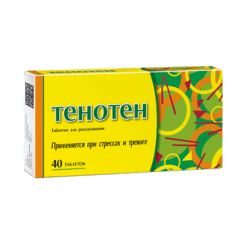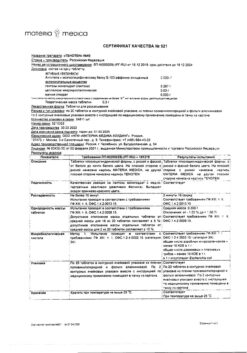No products in the cart.
Cerekard 50 mg/ml 2 ml, 10 pcs.
€1.00
Out of stock
(E-mail when Stock is available)
Description
The drug is from the group of 3-oxypyridines. It is an inhibitor of free radical processes – a membranoprotector, which also has antihypoxic, stress protective, nootropic, antiepileptic and anxiolytic effects. The mechanism of action is due to the antioxidant and membrane-protective properties. It inhibits lipid peroxidation, increases superoxidase activity, increases lipid-protein ratio, improves the structure and function of cell membrane.
. It modulates the activity of membrane-bound enzymes (calcium-independent phosphodiesterase, adenylate cyclase, acetylcholinesterase), receptor complexes (benzodiazepine, gamma-aminobutyric acid, acetylcholine), which promotes their binding to ligands, preserving the structural and functional organization of biomembranes, transport of neurotransmitters and improving synaptic transmission.
Enhances dopamine concentration in the brain. Increases compensatory activation of aerobic glycolysis and reduces the degree of inhibition of oxidative processes in the Krebs cycle in hypoxia with an increase in ATP and creatine phosphate, activates the energy-synthesizing function of mitochondria. Increases the body’s resistance to various damaging factors in pathological conditions.
It improves metabolism and blood supply of the brain, microcirculation and blood rheology, reduces platelet aggregation. It stabilizes blood cell membranes (erythrocytes and platelets), reducing the likelihood of hemolysis. It has a hypolipidemic effect, reduces the content of total cholesterol and low-density lipoproteins.
It improves functional condition of ischemic myocardium in myocardial infarction, the contractile function of heart, and also reduces manifestations of systolic and diastolic dysfunction of the left ventricle.
In conditions of critical reduction of coronary blood flow, it promotes the preservation of structural and functional organization of cardiomyocyte membranes, stimulates the activity of membrane enzymes: phosphodiesterase, adenylate cyclase, acetylcholinesterase. It supports activation of aerobic glycolysis developing in acute ischemia and promotes under hypoxia restoration of mitochondrial redox processes, increases ATP and creatine phosphate synthesis. Provides integrity of morphological structures and physiological functions of ischemic myocardium.
It improves clinical course of myocardial infarction, increases the effectiveness of therapy, accelerates the restoration of functional activity of myocardium of the left ventricle, reduces the incidence of arrhythmias and intracardiac conduction disorders. It normalizes metabolic processes in the ischemic myocardium, reduces the zone of necrosis, restores and/or improves myocardial electrical activity and contractility, as well as increases coronary blood flow in the ischemic zone, increases the antianginal activity of nitro preparations, improves blood rheological properties, reduces the consequences of reperfusion syndrome in acute coronary failure.
Indications
Indications
The drug is used as part of complex therapy for:
anxiety states in neurotic and neurosis-like conditions;
vegetative-vascular dystonia;
dyscirculatory encephalopathy;
acute cerebrovascular accidents (ischemic stroke);
mild cognitive impairment of atherosclerotic origin;
alcohol withdrawal syndrome with a predominance of neurosis-like and vegetative-vascular disorders;
acute intoxication with antipsychotic drugs;
acute myocardial infarction from the first day.
Pharmacological effect
Pharmacological effect
A drug from the group of 3-hydroxypyridines. It is an inhibitor of free radical processes – a membrane protector, which also has antihypoxic, stress protective, nootropic, antiepileptic and anxiolytic effects. The mechanism of action is due to antioxidant and membrane protective properties. Suppresses lipid peroxidation, increases superoxide oxidase activity, increases the lipid-protein ratio, improves the structure and function of the cell membrane.
Modulates the activity of membrane-bound enzymes (calcium-independent phosphodiesterase, adenylate cyclase, acetylcholinesterase), receptor complexes (benzodiazepine, gamma-aminobutyric acid, acetylcholine), which promotes their binding to ligands, preservation of the structural and functional organization of biomembranes, transport of neurotransmitters and improvement of synaptic transmission.
Increases the concentration of dopamine in the brain. It enhances the compensatory activation of aerobic glycolysis and reduces the degree of inhibition of oxidative processes in the Krebs cycle under hypoxic conditions with an increase in ATP and creatine phosphate, and activates the energy-synthesizing function of mitochondria. Increases the body’s resistance to the effects of various damaging factors in pathological conditions.
Improves metabolism and blood supply to the brain, microcirculation and rheological properties of blood, reduces platelet aggregation. Stabilizes the membranes of blood cells (erythrocytes and platelets), reducing the likelihood of hemolysis. It has a lipid-lowering effect, reduces the content of total cholesterol and low-density lipoproteins.
Improves the functional state of ischemic myocardium during myocardial infarction, the contractile function of the heart, and also reduces the manifestations of systolic and diastolic dysfunction of the left ventricle.
In conditions of a critical decrease in coronary blood flow, it helps to preserve the structural and functional organization of cardiomyocyte membranes, stimulates the activity of membrane enzymes – phosphodiesterase, adenylate cyclase, acetylcholinesterase. Supports the activation of aerobic glycolysis that develops during acute ischemia and promotes the restoration of mitochondrial redox processes under hypoxic conditions, increases the synthesis of ATP and creatine phosphate. Ensures the integrity of the morphological structures and physiological functions of the ischemic myocardium.
Improves the clinical course of myocardial infarction, increases the effectiveness of therapy, accelerates the restoration of functional activity of the left ventricular myocardium, reduces the incidence of arrhythmias and intracardiac conduction disorders. Normalizes metabolic processes in the ischemic myocardium, reduces the necrosis zone, restores and/or improves the electrical activity and contractility of the myocardium, and also increases coronary blood flow in the ischemic zone, increases the antianginal activity of nitro drugs, improves the rheological properties of blood, reduces the consequences of reperfusion syndrome in acute coronary insufficiency.
Special instructions
Special instructions
During the treatment period, care must be taken when driving vehicles and engaging in other potentially hazardous activities that require increased concentration and speed of psychomotor reactions.
Active ingredient
Active ingredient
Ethylmethylhydroxypyridine succinate
Composition
Composition
Ethylmethylhydroxypyridine succinate 50 mg/ml.
Contraindications
Contraindications
increased individual sensitivity to the drug;
acute liver and/or kidney failure;
age under 18 years (efficacy and safety have not been established);
pregnancy;
breastfeeding period.
With caution
History of allergic diseases.
Side Effects
Side Effects
Nausea, dry oral mucosa, diarrhea, drowsiness, allergic reactions.
With parenteral administration (especially intravenous jet): dryness, “metallic” taste in the mouth, sensations of “spreading warmth” throughout the body, unpleasant odor, sore throat and discomfort in the chest, feeling of lack of air (usually associated with an excessively high rate of administration and are short-term); with long-term use – nausea, flatulence; sleep disorders (drowsiness or difficulty falling asleep).
Interaction
Interaction
Enhances the effect of benzodiazepine anxiolytics, antiepileptic (carbamazepine), antiparkinsonian (levodopa) drugs, nitrates.
Reduces the toxic effects of ethanol.
Overdose
Overdose
Symptoms: sleep disturbances (insomnia, in some cases drowsiness); with intravenous administration – a slight and short-term (up to 1.5-2 hours) increase in blood pressure.
Treatment: as a rule, not required – symptoms disappear on their own within 24 hours. In severe cases of insomnia – nitrazepam 10 mg, oxazepam 10 mg or diazepam 5 mg. If blood pressure increases excessively, use antihypertensive drugs under blood pressure control.
Storage conditions
Storage conditions
List B. In a dry place, protected from light, at a temperature not exceeding 25°C. Keep out of the reach of children.
Manufacturer
Manufacturer
EcoPharmPlus, Russia
Additional information
| Conditions of storage | List B. Store in a dry, light-protected place at a temperature not exceeding 25°C. Keep out of reach of children. |
|---|---|
| Manufacturer | EkoPharmPlus, Russia |
| Medication form | solution for injections and infusions |
| Brand | EkoPharmPlus |
Related products
Buy Cerekard 50 mg/ml 2 ml, 10 pcs. with delivery to USA, UK, Europe and over 120 other countries.
















